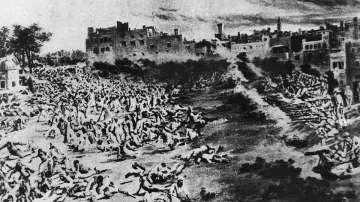April 13, 1919--The day which is marked on every Indian's mind and heart give an incurable burning pain. As India commemorates 101 years of the ghastly incident in the history of pre-independence that took over hundreds of lives, the residents of the Sikh holy city, Amritsar, are yet to recover from unforgettable pain. On this day, 101 years ago, the colonial rulers had committed a crime against humanity by launching indiscriminate firing on unarmed Sikhs who had gathered in the vicinity of the Golden Temple in Amritsar to protest peacefully.
What were the people protesting for?
On April 13, 1919, around 10,000 people gathered at Jallianwala Bagh in the afternoon to condemn the arrest and deportation of two national leaders, Satya Pal and Saifuddin Kitchlew.
What caused the Jallianwala Bagh massacre?
After the arrest of freedom fighter Saifuddin Kitchlew in early April of 1919 and the ban imposed on Mahatma Gandhi from visiting Punjab, the administration was cautious about a revolt in the state. General Reginald Dyer had issued an order barring any form of congregations in Amritsar. Since the order was not effectively disseminated, a congregation had gathered at Jallianwala Bagh on the occasion of Baisakhi. The people were unaware of the restrictions and curfew. They included unarmed men, women, and children of all ages. After the government was alerted about their presence, Dyer reached the spot with 50 soldiers armed with the rifles.
The soldiers trapped the visitors and launched an indiscriminate fire. The firing continued for the next ten minutes, killing 379 people officially and wounded 1,500 more.
What happened after the massacre?
After killing hundreds of innocent people, Brigadier Dyer walked away from the site and offered no help to the wounded. He also imposed the controversial 'Crawling order', which forced the Indians to crawl on the stretch of the road where Ms. Sherwood had been attacked. He issued a speech in Lahore on April 14 in Urdu, where he warned the locals of being shot dead if they resort to protests over the killing of civilians in Amritsar. As criticism grew, the British regime was compelled to send him back to London. He retired in 1920, retaining the rank of colonel. In 1927, he died at the age of 62 after suffering from multiple brain strokes.
Who was the Governor-General during the Jallianwala Bagh massacre?
The Governor-General of British India at the time was Michael O'Dwyer, whose reign extended from 1913 to 1919. O'Dwyer had drawn criticism for supporting General Dyer for his decision to order the firing in Amritsar. To avenge the Jallianwala Bagh massacre, Indian revolutionary Udham Singh assassinated him in Caxton, England on March 13, 1940.
Who manages the Jallianwala Bagh?
The memorial is managed by the Jallianwala Bagh National Memorial Trust. The chairman of the Trust is Prime Minister Narendra Modi.
Last year, on the occasion of 100-year anniversary of the unfortunate event, British High Commissioner to India Dominic Asquith said that Britain deeply regretted the incident. "The events of Jallianwala Bagh 100 years ago today reflect a shameful act in British-Indian history. We deeply regret what happened and the suffering caused," Asquith wrote in the visitors' book at the memorial.
"I am pleased today that the UK and India have and remain committed to developing further a thriving 21st-century partnership," he added. In his brief interaction with reporters later, Asquith said British Prime Minister Theresa May on Wednesday described the Jallianwala Bagh massacre as a "shameful scar" on British Indian history.
May, however, stopped short of offering a formal apology.
ALSO READ | Jallianwala Bagh to remain closed till June 15
Latest India News
